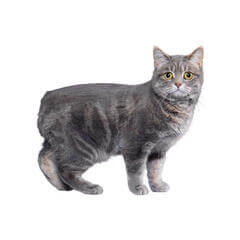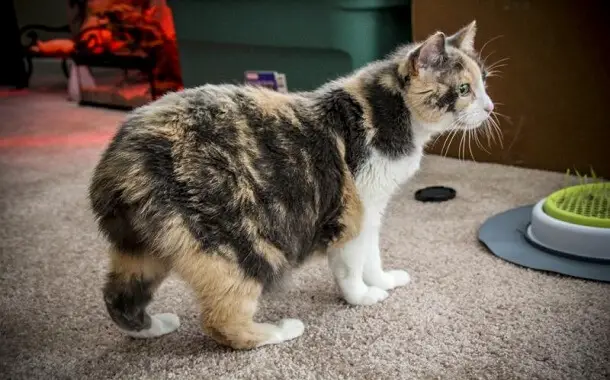How Much Does a Manx Cat Cost?
Last Updated on September 12, 2023
Written by CPA Alec Pow | Content Reviewed by ![]() CFA Alexander Popinker
CFA Alexander Popinker
This cat breed came from the Isle of Man, an island that is part of the British Archipelago. The name of this breed comes from its place of origin, Manx, and the first specimens are said to have been seen in the 18th century, coming from the ships of the Spaniards who wanted to come to Britain over 300 years ago. There are, however, many stories on the subject, including one that said it arose from the crossbreeding of the cat with the rabbits on the island.
Manx cats have a gene that causes mutations in the tail, and the kittens are born without it, and owners of this breed make sure that whenever they breed Manx cats, tailless cats are used with cats that have tails because crossing two cats that don’t have tails is, beware, lethal!
How Much Does a Manx Cat Cost?
The average cost of Manx cats is anywhere between $160 and $550, depending on the geographical location, breeder, and the colors, tail, age, and quality of the animal. Usually, the most expensive are the cats that have a bone slightly protruding where the tail should be or have no tail at all.
For example, the online classified website Hoobly.com has breeder listings for Manx kittens for sale with prices that start at around $50 for an adult cat and go up to more than $1,000.
What does the adoption fee include?
The majority of rescue groups and reputable breeders will include all up-to-date vaccinations and any necessary paperwork and, if they will not be bred, they will be neutered or spayed. In case the animal is CFA (The Cat Fanciers’ Association) registered, this paperwork must also be included. Some rescue groups or breeders may also offer a special start-up kit with toys, litter, and food.
Depending on the breeder’s policy, you can take home the kittens when they are eight to twelve weeks old. It is recommended by the experts to wait until the four-month mark because at this age the Manx Syndrom might appear and you will know exactly what you have to deal with.
Manx kittens overview
The Manx cat is very similar in type to the British Shorthair, obviously except for the tail. The body is compact and solid, with a broad chest and a short back. The rump is rounded and should be higher than the shoulders. It also has a round head. The legs are short and strong, the hind ones being slightly longer than the front ones.
You might also like our articles on the cost of Scottish Fold kittens, Abyssinian Cats, or Bombay cats.
The show cat must have absolutely no tail, and the rump must be completely rounded, but stubs of various lengths are accepted for the domestic or breeder cat. The coat of the Manx cat has a dual quality, having a thick, short undercoat and a slightly longer topcoat. You can find any combination of colors and markings except the Siamese cat pattern.
What are the additional expenses?
Depending on your local county/city ordinance, you will spend anywhere between $10 and $35 per year for the local licensing fees.
In case the cat has to be shipped to you from another state/country, then you will have to pay anywhere between $170 and $320 for transportation.
When figuring out the cost of owning a Manx cat, keep in mind that you will have to budget for recurring basic cat necessities like food, cat litter, vet visits, water bowls, and a litter box. Be prepared to spend $25 to $35 per month just for food and cat litter. This will not include any surprise and/or routine visits. For a well-balanced diet, a high-quality “growth formula” blended cat food is recommended.
Important things to consider
 When not hunting all kinds of insects or rodents and not lying in wait, the Manx cat is affectionate, emotionally balanced, and playful. The Manx cat loves to follow its favorite owner around the house and sit in his arms as soon as it gets an opportune moment. Sometimes it will vocalize at you, giving the impression that you’re having a conversation.
When not hunting all kinds of insects or rodents and not lying in wait, the Manx cat is affectionate, emotionally balanced, and playful. The Manx cat loves to follow its favorite owner around the house and sit in his arms as soon as it gets an opportune moment. Sometimes it will vocalize at you, giving the impression that you’re having a conversation.
Missing a tail is a severe genetic defect and the Manx cat’s “deformed” spine can cause problems. If certain deformed vertebrae affect the spine, the cat may be prone to arthritis from an early age. In some cats, the anus can be narrowed, which can cause intestinal blockages. The mutated gene that causes tail lessness can also be responsible for other skeletal deformities, and when two completely tailless “rumpies” mate, the kittens are often stillborn or die shortly after birth.
A Manx cat can live up to 15 years and, like its British Shorthair relatives, it is prone to obesity. Despite the lack of a tail, Manx cats have no problems with maintaining balance.
The coat of the Manx cat does not require excessive grooming or brushing, these cats being able to groom it themselves. As with any cat, regular vaccinations and deworming are recommended.
Tips for saving money
Try to focus on the breeder’s reputation and the quality of the pet, not the cost. Also, interview some breeders and ask questions to find one who meets your needs.
Take into consideration adopting a cat from a local rescue group that focuses on Manx cats. For instance, if you are living in North Carolina contact the Tailless Cat Rescue, which may help you adopt a Manx cat.


Leave a Reply
Want to join the discussion?Feel free to contribute!